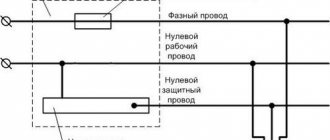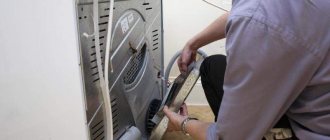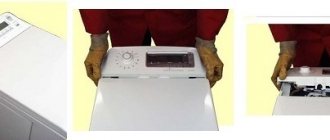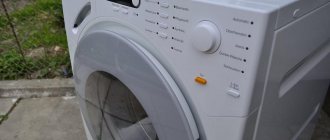Transportation regulations? It is no coincidence that new washing machines require the use of packaging for these purposes, reinforced with shock-absorbing gaskets that guarantee complete safety of the contents of the components. The mechanism of the device is sensitive to accidental shock, vibration, incorrect orientation in space, contact with moisture, etc., therefore, transportation of a device that has already been used must also be done correctly, preferably in the original box. People wonder whether it is possible to transport a washing machine while lying in the car.
Preparation for transportation
The preparatory stage of transporting SMA in a passenger car must necessarily include the following sequence of actions:
- checking the internal compartments of the device (hoses, pipes, pumps) for the presence of water in them, which can remain there for a long period after washing;
- disconnecting the drain filter and immersing the outlet of the part into a container installed below the level of the tray of the washing unit and designed to drain stagnant liquid;
- drying the internal components of the washing machine by opening the valves for a couple of hours.
Even a small amount of moisture remaining inside the device when the case is tilted can damage the electronics of the device.
Drum fixation
Experts strongly advise transporting an automatic washing machine only after first securing its drum. Poor quality of the road surface causes vibrations and pitching, as a result of which this part can cause damage to the insides of the household appliance.
Any model of washing machine comes with shipping bolts that can be used to securely secure the drum. Each transport bolt must be tightly screwed onto the rear wall of the SMA housing.
If the factory set of fasteners is lost, and the range of the nearest household appliance stores does not include this type of component, the drum can be fixed without transportation bolts.
After removing the horizontal cover of the SMA, it is necessary to place a foam gasket in the space between the drum and the inner surface of the device body. After checking the reliability of fixation of this part, the machine is almost ready for transportation.
Package
At the packaging stage, it is important to adhere to the following procedure:
- carefully twisting, wrapping in polyethylene and attaching the power cord and hose to the body using improvised means;
- fixing the detergent dispenser with adhesive tape or removing it to prevent the component from opening and falling out during transportation;
- covering the body of the washing device with several layers of protective film (if this is not available, it is necessary to take care of the external protection of the machine with blankets and materials that can act as a shock absorber in the event of a possible impact).
The packaging materials are secured on the outside with twine or tape.
Preparation
Preparation for transportation of SMA - automatic washing machine.
“>SMA is the main factor in the success of this event. It is almost unrealistic to assume that the original packaging has been preserved. However, it is necessary to spend time searching for shipping bolts. They are needed to secure the drum, one of the most important and fragile parts of the machine.
The rear wall has holes for bolts through which the tank is secured. These technological fastening elements do not allow it to move inside the machine when it is tilted during transportation. This protects both the tank itself and other parts responsible for its performance from damage: shock absorbers, bearings, body panels.
Considering the importance of transportation bolts when moving the washing machine, take measures to preserve them for a long time. One option is to attach it to the back wall of the washing machine, packing it in a special plastic bag.
If the shipping bolts were not found, you can secure the drum using materials such as corrugated cardboard, foam plastic, or soft fabric. To do this, you need to remove the top or back walls of the machine (you can have two at once) and fill the free space between the drum and the body with the specified material. After this, put the walls in place, first checking the tightness of the tank packaging.
Before designing your homemade packaging, you must complete the following steps:
- secure electrical wiring and water hoses to the body;
- drain all water that may remain in the washing machine system (hoses, pump, drain);
- dry, leaving the laundry load lid open;
- wipe the powder container dry and secure it with tape to prevent it from falling out during transportation;
- for machines with vertical loading, only the hatch needs to be secured, since the powder container is built into it or absent;
- To make it easier to carry by hand, cover the sharp parts of the washing machine with tape.
After carrying out the above steps, to prevent damage to the SMA body, use an automatic washing machine.
“>SMA, it needs to be packaged. For this purpose, it is necessary to use materials that can soften the possible impact load. Typically, stretch film, corrugated cardboard, and bubble film are available. If there is a shortage of these materials, you can wrap the machine with a blanket. Be sure to secure this shell tightly with twine.
How to transport it correctly
After all fragile elements of the automatic washing device are protected from factors that could harm the operation of the device during transportation, you need to study the list of recommendations for the safe transportation of AGRs:
- when loading, the washing machine may tilt slightly towards its rear panel;
- It is not permitted to transport such electrical appliances in a horizontal position;
- the optimal vehicle option for transporting a washing unit is a small truck, the use of which minimizes the risk of damage to the body and internal components of the AGR as a result of falls and impacts;
- the washing appliance can be loaded in such a way that the machine first lies on its side and then assumes a vertical position;
- a layer of rags or other soft materials should be laid under the transported SMA, which will act as additional shock absorption when the vehicle moves;
- a passenger car (its interior or luggage compartment) is not intended for transporting such fragile large items: such a method of transportation is fraught with damage.
Transporting the washing machine
How to transport a washing machine so that it is not damaged in transport? A properly packaged unit is completely ready for manual carrying and loading into a car. The best vehicle option is a truck with a spacious body, but you can transport the product in a passenger car. When carrying, try to keep the appliance in an upright position, even if you are lowering it from the upper floors. It is impossible to cope with such a task alone; at least two people must carry the washing machine. Professional movers use special lifting belts for carrying, with which the weight of the machine is practically not felt, and the risk of damaging or dropping an item is minimized.
You need to carry a household appliance by holding it in an upright position.
Next, you need to decide exactly how the equipment will be installed in the car. If you cannot transport the machine horizontally, is it possible to transport the washing machine lying down? Subject to certain rules - yes. For transportation, it is recommended to choose one of three positions: lying on the side or rear wall or in the normal standing position for the unit. Let's consider the proposed options in more detail:
- The standing position is considered the most successful for the machine, but is used only when the tank is securely fixed. The equipment must be installed sideways in the direction of travel. It is advisable to fix the machine between two massive objects, such as pieces of furniture. If this is not possible, it is recommended to secure the unit in the body using special belts. In this position, ideal preservation of parts is achieved;
- position on the side , according to experts, does not necessarily require securing the drum in one position, but it is still better to play it safe and fix it. Pay attention to the powder compartment - it is important that there is no water in it, which can flood the electronic board and ruin it;
- The position on the rear wall is acceptable for all brands of units except Zanussi models. If you transport a machine of this brand by placing it on the back panel, you can damage the fill valve.
To transport the unit safely, ensure that it is completely stationary in the vehicle.
It is not recommended to transport the washing machine lying on the front wall or upside down. In the first case, the manhole cover and the drum cuff may not be able to withstand the load. Installing the machine in the body with the top panel down is permitted in a situation where the engine is removed from the structure.
You can secure the machine in the car using belts.
To ensure that the device remains intact after a trip, you should drive the car carefully. It is important to travel on smooth roads at a moderate speed, avoiding sharp turns and braking. If you follow all the recommendations given, the transportation of the washing machine will be successful.
Is it possible to transport a washing machine on its side?
The only correct and safe way to transport SMA involves the use of vehicles specially designed for cargo transportation in Moscow and large cities.
The internal space of their vans will allow you to transport the electrical appliance in an upright position. But the question arises: is it possible to transport a washing machine lying down? This position of the electrical appliance during transportation can only be forced when a passenger car is chosen as the vehicle.
Transporting an electrical device in a horizontal position will not lead to damage to the internal mechanisms if its body is laid on its side (on the rear panel) and securely fixed on the surface of the luggage compartment, roof or interior of the car, covered with a soft layer of shock-absorbing material. The machine should be turned sideways in the direction of travel.
In what position can the washing machine be transported?
After preparing the device for transportation, you can proceed to the stage of transfer and loading into the car. When lowering the washing machine from top to bottom, some problems may arise due to its considerable dimensions and weight. According to the recommendations of experts, at the stage of transferring from an apartment to a vehicle, such equipment should be in a vertical or slightly tilted position back.
The next task is to load the automatic machine into a truck or car. And it is at this stage that a serious question arises - how to properly transport the washing machine. There are 3 options for transporting a washing machine:
- Vertical;
- Lying on your side;
- Lying down, using the back wall.
When choosing a transportation option, you should take into account the overall characteristics of the vehicle.
What are the dangers of incorrect transportation?
Failure to comply with the rules for transporting household AGRs is fraught with violations that are incompatible with its further functionality. Improper transportation of the washing machine can lead to the following negative consequences:
- breakdown of the drain pump;
- the compartment for detergents falls out and the integrity of its body is damaged;
- occurrence of malfunctions in the control panel;
- short circuit of electronics due to contact of contacts and wiring with liquid;
- the formation of holes, cracks, kinks in pipes and hoses;
- shock absorber failure;
- rupture or bending of the power cord;
- the appearance of tears in the cuff.
Damage to external elements may also occur: the hatch or its hinges, the body (the appearance of chips as a result of strong impacts).
Preparing SMA for transportation
Before leaving, take care of your packing. The best option is an original box, in the walls of which you place sheets of foam plastic or foam rubber pieces. Of course, the washing machine may not have lasted more than 2 or 3 years, which means that the original packaging cannot be found, not to mention the fasteners and other components. You will have to get out on your own, improvising with what you have. When preparing the unit for transportation, follow the recommendations of specialists:
- Disconnect communications: electricity and hoses connecting the device to the water supply and sewerage.
On a note! Technicians have recorded cases when, in a hurry, the car begins to be pushed and moved, forgetting to unplug it from the socket or without disconnecting the hoses.
- Drain the remaining water from the SMA. It can remain in hoses, pipes, powder containers and pumps. When transporting, especially on its side, it will definitely spill, creating inconvenience and a dangerous situation for the machine itself.
What is the danger? If water spills, it can get on the control board, which is why the electronic panel runs the risk of being damaged. Expensive repairs or the purchase of new equipment await you.
- Secure the power cord and hoses with the latches provided on the housing. If they are not available, use improvised materials - adhesive tape, electrical tape.
- Using a roll of tape, wrap around the sharp protrusions of the case. Secure the powder pick-up so that it does not fall out or break.
- The last stage is fixing the tank. During a long move to another city, the tank is secured with transportation bolts, the purpose of which we wrote about earlier. If they are not preserved, they will have to be transported without shipping bolts. To do this, the CMA cover is dismantled, and foam or foam pieces are placed between the tank and the body to secure the drum located in the tank. Then these nodes will not be damaged by vibrations. You can also use cardboard, unwanted clothes, etc. Then the lid is screwed into place.
How to pack SM when moving if there is no box from the store?
After the procedures, wrap the equipment in fabric (an old blanket will do) or film with “pimples” and secure with a cord or rope. Having done everything carefully and correctly, you can easily transport the automatic washing machine without harming it.
How to prepare a washing machine?
Before transportation, it would be correct to place the washing machine in the original packaging, and put polystyrene or foam rubber in the wall, but this is the ideal option. Most often, a washing machine that has worked for more than a year does not have any intact packaging, but also no components or fasteners at all. Therefore, during transportation you will have to improvise. In the process of preparing the washing machine for transportation, first of all, you need to do the following.
- Disconnect the washing machine from electrical and water supplies. At first glance, this seems funny, but there are a huge number of cases when the machine begins to be moved without disconnecting the hoses or one of the hoses. And often simply by not disconnecting the power cord. What happens after this can be easily guessed.
- Remove any remaining water from the machine. Water stagnates in hoses, pipes, and drain pump and can cause trouble when transporting a household appliance.
- Secure the hoses, wires, hatch, so that all this does not dangle and does not interfere with moving the washing machine.
- Cover all sharp corners and protruding sharp parts of the washing machine with tape to avoid injury when carrying the machine.
After this, you need to take measures to fix the washing machine tank. The best fixation option is transportation bolts, which are screwed through holes in the back wall of the washing machine. Read more about installing and removing shipping bolts in this article.
If the transport bolts have not been preserved, then you need to open the upper wall of the washing machine by unscrewing several bolts, and then put foam rubber, polystyrene foam, clean rags, etc. in the space between the tank and the walls. Then you need to return the upper wall back along with the fasteners.
After you have secured the tank, wrap the body of the washing machine in fabric and tie it with twine. If you carry out all the above steps, you can successfully transport the machine without the original packaging, you just need to be careful.











